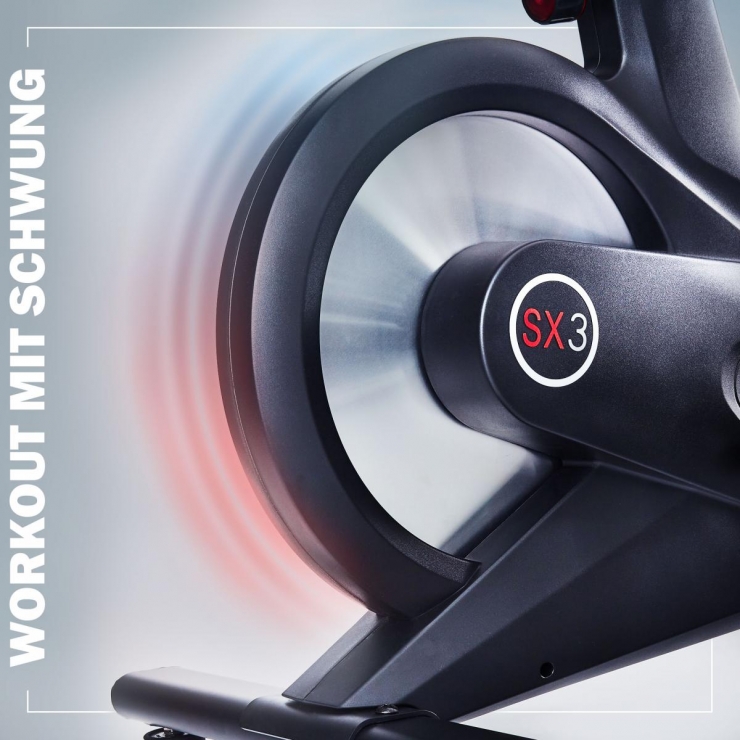If you’re in the market for an exercise bike, the good news is that there’s no shortage of options!
But with so many features to consider, it can be tricky to make the right choice for your workout needs.
One of the most important aspects to consider when choosing an exercise bike is the type of resistance it houses.
Today, we’re explaining the ins and outs of magnetic resistance bikes.
What Is a Magnetic Resistance System?
Indoor exercise bikes, also known as stationary bikes, are equipped with a component called a flywheel.
A flywheel is a metal disk linked to the bike’s pedals. It stores energy from the pedaling motion and uses a form of resistance to exert a braking effect that makes pedaling easier or harder.
A few of the most common forms of resistance include magnetic, mechanical, and air resistance.
The magnetic resistance system operates based on the magnetism principle. Instead of using brake pads like typical friction-resistance bikes, magnetic bikes rely on powerful magnets to produce frictionless resistance.
How Does It Work?
Mechanical resistance systems feature two strong magnets. These magnets never come in contact with the flywheel.
When the user pedals, the flywheel components move between these two magnets and interfere with their magnetic field, yielding an opposite force. This generates tension against the flywheel.
When you increase the resistance level via a knob or digital controls, the magnets move closer to each other and the flywheel, producing a greater opposing force that makes pedaling harder.
When you decrease the resistance level, the magnets move away from each other and the flywheel, producing a lower opposing force that makes pedaling easier.
What Are the Advantages of Magnetic Bikes?
There are several pros to owning a magnetic bike. Some of the top ones include:
They’re Quiet
The fact that magnetic exercise bikes don’t rely on friction to produce resistance makes their operation quiet.
In stationary bikes, something actually touches the flywheel. The friction results in noise, which doesn’t occur in magnetic bikes as nothing comes in contact with the flywheel.
They’re Durable
Magnetic bikes are a lot more durable than contact-based resistance types.
The frictionless operation of magnetic bikes makes the flywheel significantly less prone to wear and tear with use.
So if you’re looking for a long-lasting investment, a magnetic exercise bike is. The way to go.
They Don’t Require Frequent Maintenance
Building on the previous point, the reduced wear and tear results in fewer maintenance requirements for magnetic bikes. Using contact-based resistance, you won’t need to fix or replace parts as frequently as on bikes.
They Offer Various Resistance Levels
Magnetic resistance bikes come with high adjustability regarding the level of resistance you can use.
All you need to do is turn a knob or press a button, and you can change the resistance level within a wide range of options.
As such, magnetic bikes are usually equipped with numerous built-in exercise programs that target different goals.
You can also personalize the resistance level to achieve a heart rate that matches your fitness needs.
Note that on the market, you can find both upright and recumbent bikes with this type of resistance system.
How Do Other Resistance Systems Compare?
As mentioned earlier, mechanical and air resistance are commonly used in indoor exercise bikes. Let’s take a quick look at how they differ from magnetic resistance :
Mechanical Resistance
Also known as contact resistance, mechanical resistance is a type of resistance that involves generating friction. It’s the staple system for spin bikes.
The flywheel touches a leather or felt pad as you pedal in mechanical resistance.
This movement creates friction that yields resistance. The more pressure the pad applies against the flywheel, the harder the pedaling becomes.
This contact is the reason why mechanical resistance bikes are louder and less durable than magnetic models.
Air Resistance
In air bikes, the resistance system relies on the movement of fan blades through the air.
When you pedal at low speed, there’s less resistance because the fan blades aren’t pushing much air out of their way.
However, with increasing speed, the fan blades must push against stronger air flow, so the resistance is greater.
Final Thoughts
Instead of using brake pads for contact resistance or using blades for air resistance, magnetic bikes rely on powerful magnets to produce frictionless resistance. This results in a much quieter operation with less wear and tear.
